
If this article reads more musical than usual, itÂ’s because IÂ’m practicing my preaching: IÂ’ve got pTunes on my Treo 680 piping through my Palm Hybrid Headset/Headphones while I slave away at the wordprocessor. Music soothes the soul, and mine definitely needs soothing, but in this antique high-rise I get the additional benefit of drowning the drone of the window air conditioner that keeps me cool. Did I mention three computers and their peripherals, each with fans and motors?
You probably already know about Pocket Tunes – pTunes in the Apps screen - Treos’ built-in MP3 music player. Set it going in the background and listen to music while you do other things like talk on the phone, skate, jog, bicycle, work out, sew, commute, stroll, or write articles for TreoCentral. However, often it’s inconvenient to poke Treo buttons or tap icons to change its tune. So much easier to bark “Next Track!” and have pTunes make the changeover.
VoicePlayIt, a new PalmOS program from VoiceIt Technologies, lets me do just that. I say “Previous Track,” and it returns to Rossini. “Next Track” goes to the Gershwin, then “Repeat Track” keeps the “Rhapsody in Blue” or the “Concerto in F” playing until I command “No Repeat.” It’s all so sweet it seems like pure magic -- after some setup and a quick training session that lets the program know what I sound like when I drawl “Stop,” “Play” and the other commands.
Usability
I found VoicePlayIt to be easy as rhubarb pie to set up the first time, despite a lack of instructions for doing so. Before we go any further, let me emphasize that VoicePlayit does not work with Bluetooth headsets. You must have a wired headset or earphones that have a built in microphone, and the thing must be plugged in to the Treo before you try to train its voice recognition. Sure, Treos have a microphone, but the training canÂ’t operate with it. The program wonÂ’t detect that thereÂ’s no headset plugged in, so youÂ’re on your own to read the caveat. I didnÂ’t, and got frustrated.
Once I figured this out, a decidedly “duhhhhh” situation I admit, voice training sailed along. The defaults worked perfectly with the Palm headphones the first time, and the program behaved reliably on the first attempt.
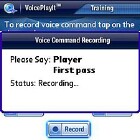
If you don’t turn the automation off, VoicePlayIt’s mellifluous-voiced female narrator gently directs you to speak commands in turn after waiting a full second past the proverbial “beep.” The delay gives the program time to assess and compensate for background noise. You utter each command three times – practice makes perfect – and when done the program displays an amplitude graph of the resulting digitized command and speaks it back to you, automatically storing it. The other buttons don’t do anything while you’re in automation mode – really, they ought to be covered up or removed, as they can confuse.
Disable the automation (see the “Settings” panel from the program’s main screen), and you can replay, re-record, and skip around among the commands to listen to or re-do them. For first time use, the automation is brilliant, a welcome, considerate touch. I turned the voice prompts off after I learned the drill.

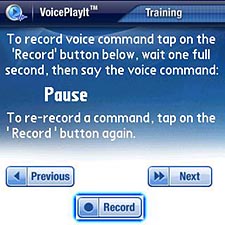

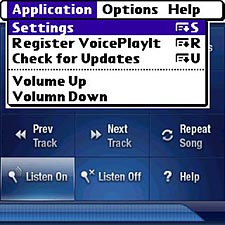
The program recognizes the commands “Play,” “Stop,” “Pause,” “Next Track,” “Previous Track,” “Shuffle,” “No Shuffle,” “Song Info,” “Repeat Song,” “No Repeat,” “Manage Playlist,” “Volume Up,” and “Volume Down.” In addition, “Player,” which comes first in the training sequence, can implement an addressing system to prevent accidental commands. If the option is checkmarked in Settings, you have to speak “Player” before any command, a slow process, but it could be useful.

The control screen offers buttons which operate pTunes just like the voice commands, and the top-leftmost one brings up the pTunes display itself. Use the Apps button to return.
Operation

After training the program, the next step is to get some music going. The company recommends playing MP3 music from an SD card, and so do I. The cards make a convenient way to organize a music library, donÂ’t take up valuable system memory, and you can make up several with different selections. The program itself must live in device memory, of which it consumes about a megabyte. It can be slimmed down to 110 kilobytes by using FileZ or other utility to remove the graphics and voice over files vpit-001.prc and vpit-wave.prc, but donÂ’t do this till you know the program well. Do not remove anything else!

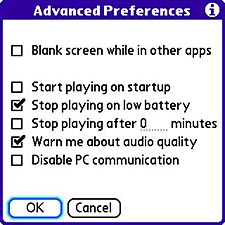
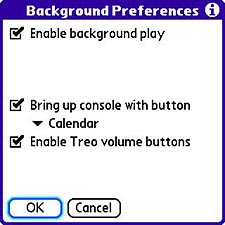
Besides having a wired headset or earphones hooked up, VoicePlayIt depends on pTunes’ “Background” mode. Pull down the pTunes menu (Menu button or tap the top-left edge of the screen), choose Prefs > Background Prefs and then checkmark “Enable Background Play.” For VoicePlayIt to work, you have to run pTunes first. Select some music – tap the musical notes icon to choose a source if none is shown – then tap the icon to play. To have pTunes cycle through available tracks, use the “Select all” option before you play.
With music coming out of your headphones, press the Treo’s Apps button (“Home” by any other name), and tap the VoicePlayIt icon. If you don’t turn off voice announcements, it welcomes you, even over the music. Tap the “Listen On” button (bottom row). When you start the program, the “Listen On” button is highlighted, but the program is NOT listening for your commands. You have to tap the button, even though it’s lit up. This could use some rethinking.
While “listening” VoiceDialIt awaits your command. “Listening” appears in the status bar at the top of the screen. Say “Pause” or “Next Track,” and the program goes through some calculating – it announces what it’s doing in the status bar – replays what it heard (unless you turn that option off), displays its translation if it recognizes the command, and pipes the result to pTunes, which isn’t even visible. In a few seconds, pTunes will comply with the request after a beep. Beeps are good.
Incoming
What if the phone rings? No problem there; pTunes already knows how to handle the situation, and VoicePlayIt cooperates. The music pauses, resuming when the call terminates. Beautiful.
The “Listen Off” button is useful if you need to talk to other people in the room, in the café, on the treadmill machine, wherever. VoicePlayIt tries to recognize anything it hears, including cats’ meows, sneezes, doorbells, and anything else it thinks is above the ambient level you trained it to ignore. To keep it from getting confused, just have it stop listening till you need it. An “Unlisten” voice command would be welcome, but there isn’t one.
The program doesn’t know or care what words you say or in what language, though its interface is only English. I spoke “fatiddle,” instead of “Play,” during training, and it worked. I also tried changing the background noise without re-training the program. Reducing it made no difference – the commands still did their thing – but changing its whole character didn’t set well. For best results, train the program in the environment in which it will be used. Really, though, for lower amounts of ambient sound than my office is beset with, this probably won’t make as much difference.
A word of caution. The company’s promos rave, “VoicePlayIt really comes in handy while you are in the car…” Wait!
Please, please donÂ’t block up both your ears while youÂ’re driving. I might need to blow my horn at you!
There’s not much documentation in the program itself. The “tips” screens are nearly useless, except for reminding about the settings for pTunes v4, and a couple of other gotchas. However, the company’s website includes a forum section dedicated to the program. There’s not much there yet, because the program has only been available since mid May 2007, but this is the place to ask questions and benefit from other people’s experiences.
You can download (or view) a fairly decent documentation in PDF format at this link.
Settings
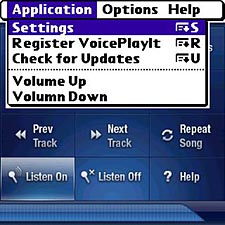
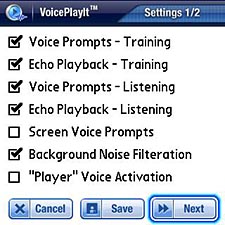
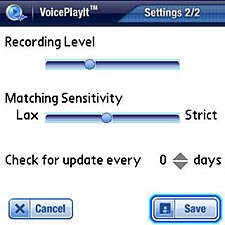
VoicePlayIt offers settings that let you turn off its training wheels when you’re ready. You can, for example, disable the friendly voice prompts to speed up operating the program. The defaults for Recording Level and Matching Sensitivity worked the first time for me, but you can adjust them if the program misidentifies commands, or to fine tune the recording process. Two things are missing, however. There are no ticks to indicate what the settings are, no indication of how fine the fine tuning is. And there’s no “Reset” option that I could find. With no tick marks, it’s impossible to know where the original settings might be after you’ve moved them.
I gave VoicePlayIt a bad-case scenario, my office, and purposely tried to defeat it by speaking its commands with different inflexions – a slur, a lilt, a drop. The program figured them out uncannily, and appeared to have no difficulty dealing with high ambient noise, even though its maker warns against such situations. Oddly, I found that it worked much better with my Palm Hybrid Headset than with my high-end The Boom Quiet headphones. It took some fiddling with these microphone and sensitivity settings to get The Booms to work with the program. Maybe the Quiet is so quiet the program cannot believe what it’s getting.
You can get VoicePlayIt here for $19.95.
Next Page: Conclusion >>